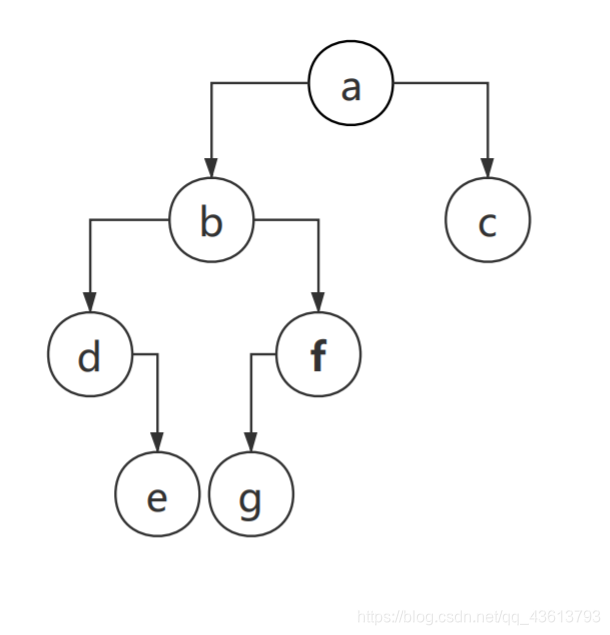首先介绍二叉树的前序、中序、后序遍历:
二叉树的前序遍历:
1)首先访问根节点
2)然后按照前序遍历的方式访问根节点的左子树
3)最后按照前序遍历的方式访问根节点的右子树
二叉树的中序遍历:
1)首先按照中序遍历的方式访问根节点的左子树
2)然后访问根节点
3)最后按照中序遍历的方式访问根节点的右子树
二叉树的后序遍历:
1)首先按照后序遍历的方式访问根节点的左子树
2)然后按照后序遍历的方式访问根节点的右子树
3)最后访问根节点
来看这样一棵二叉树:

根据以上二叉树遍历的定义,得到该二叉树的遍历结果:
前序:abdefgc
中序:debgfac
后序:edgfbca
为了更直观一点,我们将二叉树补全:

这样得到的结果就变成了:
前序:abd#e##fg###c##
中序:#d#e#b#g#f#a#c#
后序:##e#d#g##fb##ca
这里我们采取链式存储方式来建立二叉树。因为顺序存储必须预先给出数组的大小,但是在某些情况下数组大小是难以确定的。链式存储则可以避免这个问题。
链式存储方式下二叉树的节点构如图:

其中lchild是指向该节点左子树的指针,rchild是指向该节点右子树的指针。
那么开头那棵二叉树的链式存储就可以表示为:

二叉树的前序创建:
可以用递归方法实现:
typedef struct node{
char chars;
struct node *lchild, *rchild;
}bintnode;
typedef bintnode* bintree;
bintree createbintree() {
char ch;
bintree t=NULL;
if ((ch = getchar())== '#')
t = NULL;
else {
t = (bintnode*)malloc(sizeof(bintnode));
t->chars = ch;
t->lchild = createbintree();
t->rchild = createbintree();
}
return t;
}
二叉树遍历的非递归实现:
在采用非递归方式实现二叉树遍历时,需要用栈来记录回溯点:
typedef struct stack {
bintree data[100];
int tag[100]; //后序遍历标记
int top; //栈顶指针
}seqstack;
void push(seqstack* s,bintree t) {
s->data[s->top] = t;
s->top++;
}
bintree pop(seqstack* s) {
if (s->top != 0) {
s->top--;
return(s->data[s->top]);
}
else
return NULL;
}
前序:

void preorder(bintree t) {
seqstack s;
s.top = 0;
while ((t) || (s.top != 0)) {
if (t) {
printf("%c", t->chars);
push(&s, t);
t = t->lchild;
}
else {
t = pop(&s);
t = t->rchild;
}
}
}
中序:

void inorder(bintree t) { //中非
seqstack s;
s.top = 0;
while ((t) || (s.top != 0)) {
if (t) {
push(&s, t);
t = t->lchild;
}
else {
t = pop(&s);
printf("%c", t->chars);
t = t->rchild;
}
}
}
后序:
后序遍历的特别之处:
后序遍历时,当一个元素位于栈顶即将出栈时,说明该元素的左子一定以经遍历完成,如果其右子树不为空,此时应进入其右子树进行访问,该元素不能出栈。但是这就违背了栈“后进先出”的概念。所以我们需要一个标记,来记录某个元素是否可以出栈:当标记为0时,说明该元素右子还未被访问,应先去访问右子;当右子访问完时,标记变为1,说明该元素可以出栈了。

void postorder(bintree t) { //后非
seqstack s;
s.top = 0;
while ((t) || (s.top != 0)) {
if (t) {
s.data[s.top] = t;
s.tag[s.top] = 0;
s.top++;
t = t->lchild;
}
else {
if (s.tag[s.top - 1] == 1) {
s.top--;
t = s.data[s.top];
printf("%c", t->chars);
t = NULL;
}
else {
t = s.data[s.top - 1];
s.tag[s.top - 1] = 1;
t = t->rchild;
}
}
}
}
最后是完整的代码:
#include<stdlib.h>
#include<stdio.h>
#define MAXSIZE 20
typedef struct node{
char chars;
struct node *lchild, *rchild;
}bintnode;
typedef bintnode* bintree;
typedef struct stack {
bintree data[100];
int tag[100]; //后序遍历标记
int top; //栈顶指针
}seqstack;
void push(seqstack* s,bintree t) {
s->data[s->top] = t;
s->top++;
}
bintree pop(seqstack* s) {
if (s->top != 0) {
s->top--;
return(s->data[s->top]);
}
else
return NULL;
}
bintree createbintree() { //前建
char ch;
bintree t=NULL;
if ((ch = getchar())== '#')
t = NULL;
else {
t = (bintnode*)malloc(sizeof(bintnode));
t->chars = ch;
t->lchild = createbintree();
t->rchild = createbintree();
}
return t;
}
void preorder(bintree t) { //前非
seqstack s;
s.top = 0;
while ((t) || (s.top != 0)) { //树不为空或栈不为空
if (t) {
printf("%c", t->chars);
push(&s, t);
t = t->lchild;
}
else {
t = pop(&s);
t = t->rchild;
}
}
}
void inorder(bintree t) { //中非
seqstack s;
s.top = 0;
while ((t) || (s.top != 0)) {
if (t) {
push(&s, t);
t = t->lchild;
}
else {
t = pop(&s);
printf("%c", t->chars);
t = t->rchild;
}
}
}
void postorder(bintree t) { //后非
seqstack s;
s.top = 0;
while ((t) || (s.top != 0)) {
if (t) {
s.data[s.top] = t;
s.tag[s.top] = 0;
s.top++;
t = t->lchild;
}
else {
if (s.tag[s.top - 1] == 1) {
s.top--;
t = s.data[s.top];
printf("%c", t->chars);
t = NULL;
}
else {
t = s.data[s.top - 1];
s.tag[s.top - 1] = 1;
t = t->rchild;
}
}
}
}
int main() {
bintree root;
root = createbintree();
preorder(root);
printf("\n");
inorder(root);
printf("\n");
postorder(root);
printf("\n");
return 0;
}
程序运行结果(以文章中的例子为例):
注意:
按照前序建立(输入)时,应按照如图所示顺序输入:

